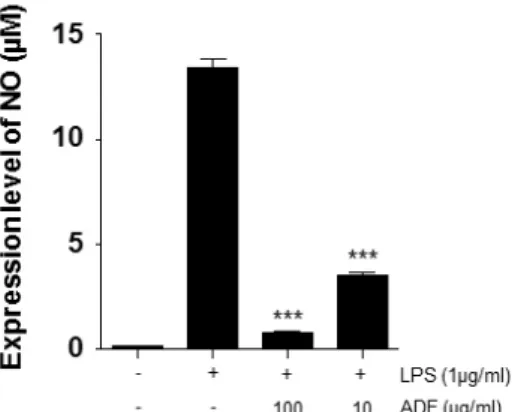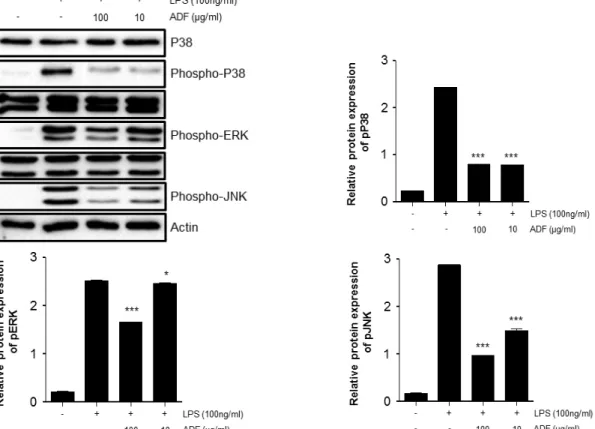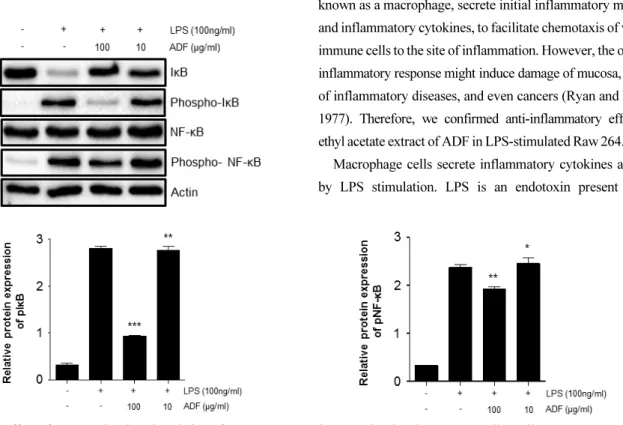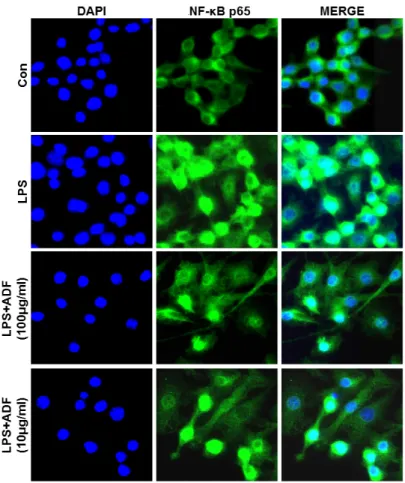Introduction
Inflammation is one of the local defense reaction of the vital tissues to external stimulus (Libby et al., 2002). If the inflammation occurs, numbers of inflammatory mediators are produced. As a result, symptom appear such as the fever, erythema and edema (Iwalewa et al., 2007). Furthermore, ongoing inflammatory reaction was induced dysfunction by promote the damage of the mucosa and have the onset and deep relationship, such as arthritis and cancer (Grivennikov et al., 2010).
Macrophage is known as a major cells involved in the inflammatory response after infection has occurred. Macrophage plays an important role in the body's defense system by producing cytokines and nitric oxide (NO) (Fujiwara and Kobayashi, 2005; Guo and Wang, 2017; Opal and DePalo, 2000). These inflammatory mediators induce an effective and rapid inflammatory response to activate host defense mechanisms against various infected agents. However, if the immune response is not appropriate, it is possible to inflammatory
disease occurs. Macrophages regulate inflammatory responses by lipopolysaccharide (LPS) present in outer membrane of Gram-negative bacteria (Axtelle and Pribble, 2001). Upon those immunological response induced by LPS, several inflammatory mediators such as NO, tumor necrosis factor- α (TNF-α), interleukin-1β (IL-1β), interleukin-6 (IL-6) are produced to activate an important transcription factor (Aderem and Ulevitch, 2000; Hoshino et al., 1999; Lazarov et al., 1999).
Such inflammatory mediators are also required to protect the damaged tissue repair. Further, in order to maintain biological homeostasis, regulation of the inflammatory response is very important.
NF- κB, one of the important transcription factors which relate to immune response, is activated by oxidative stress (Nair et al., 2004), cytokines and external stimuli, then induce expression of many genes involved in inflammatory response (Ghosh and Hayden, 2008). Expression of immunologically important proteins such as MMP-9, inflammatory cytokines and iNOS, is regulated by a transcription factor NF-κB. NF-κB is composed of p65, p50, inhibitor kappa B (IκB). Once IκB is degraded, p65 / p50 heterodimer are known to go to the nucleus
Anti-inflammatory Effects of Abeliophyllum distichum Flower Extract and Associated MAPKs and NF-κB Pathway in Raw264.7 Cells
Jin-Wook Lee and Yoon-Joong Kang*
Department of Biomedical Science, Jungwon University, Goesan 28024, Korea
Abstract - Abeliophyllum distichum is a medicinal plant used in regional traditional medicine to relieve pain in inflammatory processes. In this study, anti-inflammatory effects of Abeliophyllum distichum flower (ADF) extract were examined.
Furthermore, possible molecular mechanisms of the anti-inflammatory effects were dissected. The anti-inflammatory activity was investigated by inhibition of lipopolysaccharide (LPS) induced pro-inflammatory cytokine production in murine macrophage-like cell line Raw264.7 cells. The measurement of the induced pro-inflammatory cytokine levels were carried out by ELISA. The phosphorylation of ERK1/2, JNK, and MAPK, and the nuclear expression of nuclear factor NF-κ B p65 were investigated by Western blot analysis. The extract of ADF significantly decreased the production of pro-inflammatory cytokines. In addition, the extract suppressed the phosphorylation of ERK1/2, JNK, and p38 MAPK, and the nuclear translocation of NF-κB p65 in activated cells. Our findings provide evidence for the popular use of Abeliophylli distichum in inflammation around Goesan region and also suggest that the flower extract has potential therapeutic benefits against various inflammatory diseases.
Key words – Abeliophyllum distichum, Anti-inflammatory, Flower extract, NF-κB
*Corresponding author. E-mail : yjkang@jwu.ac.kr Tel. +82-43-830-8603
ⓒ 2018 by The Plant Resources Society of Korea



